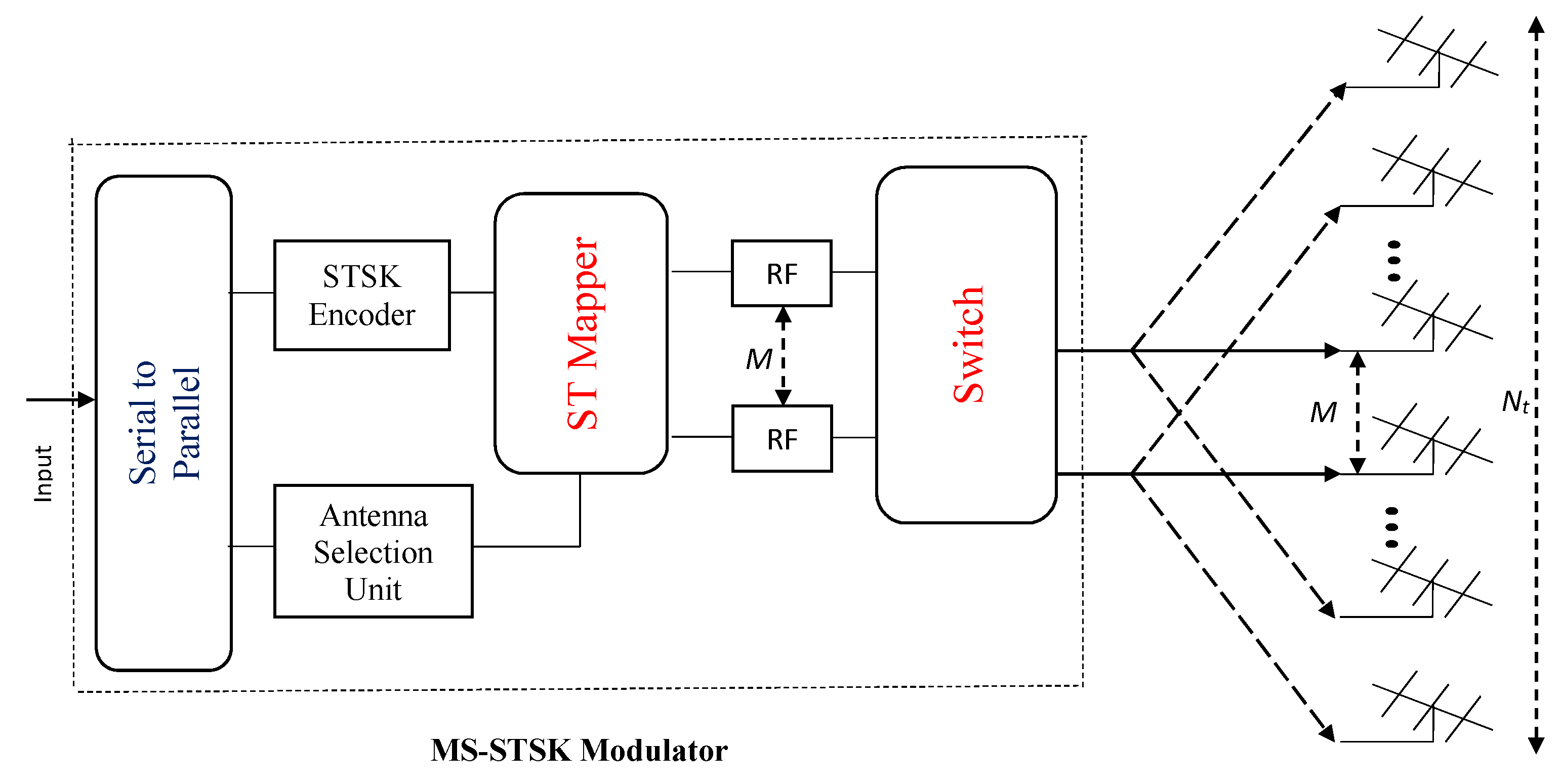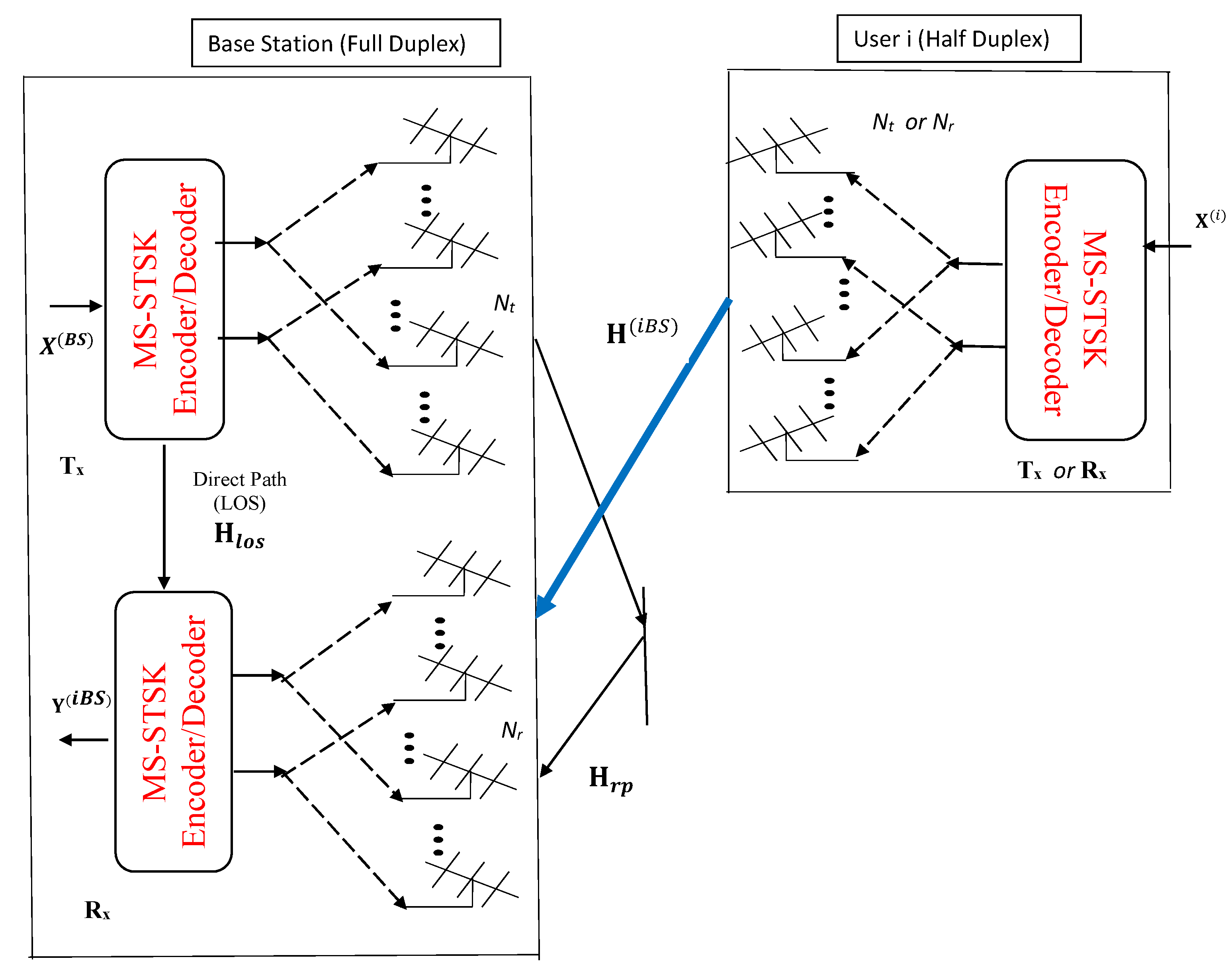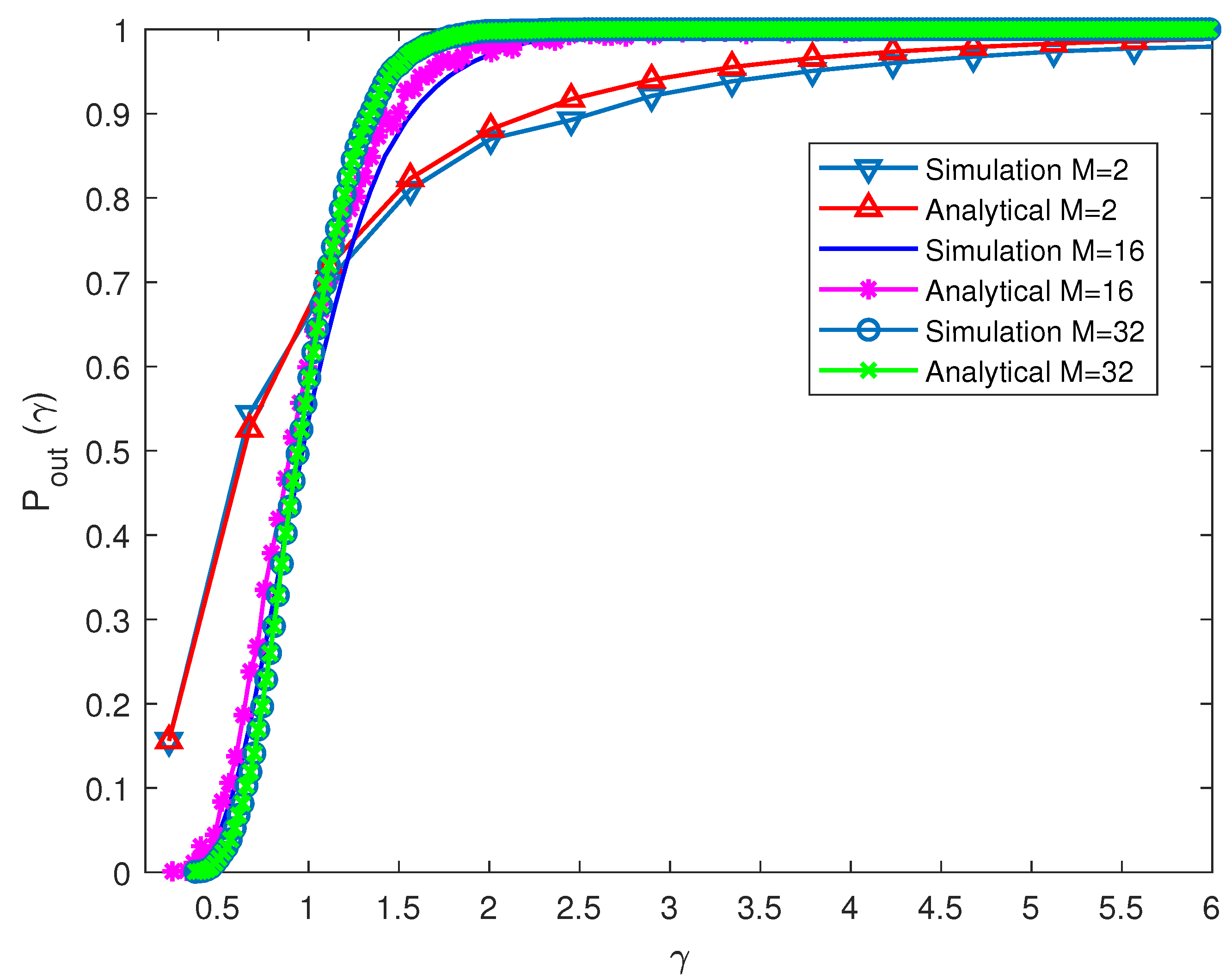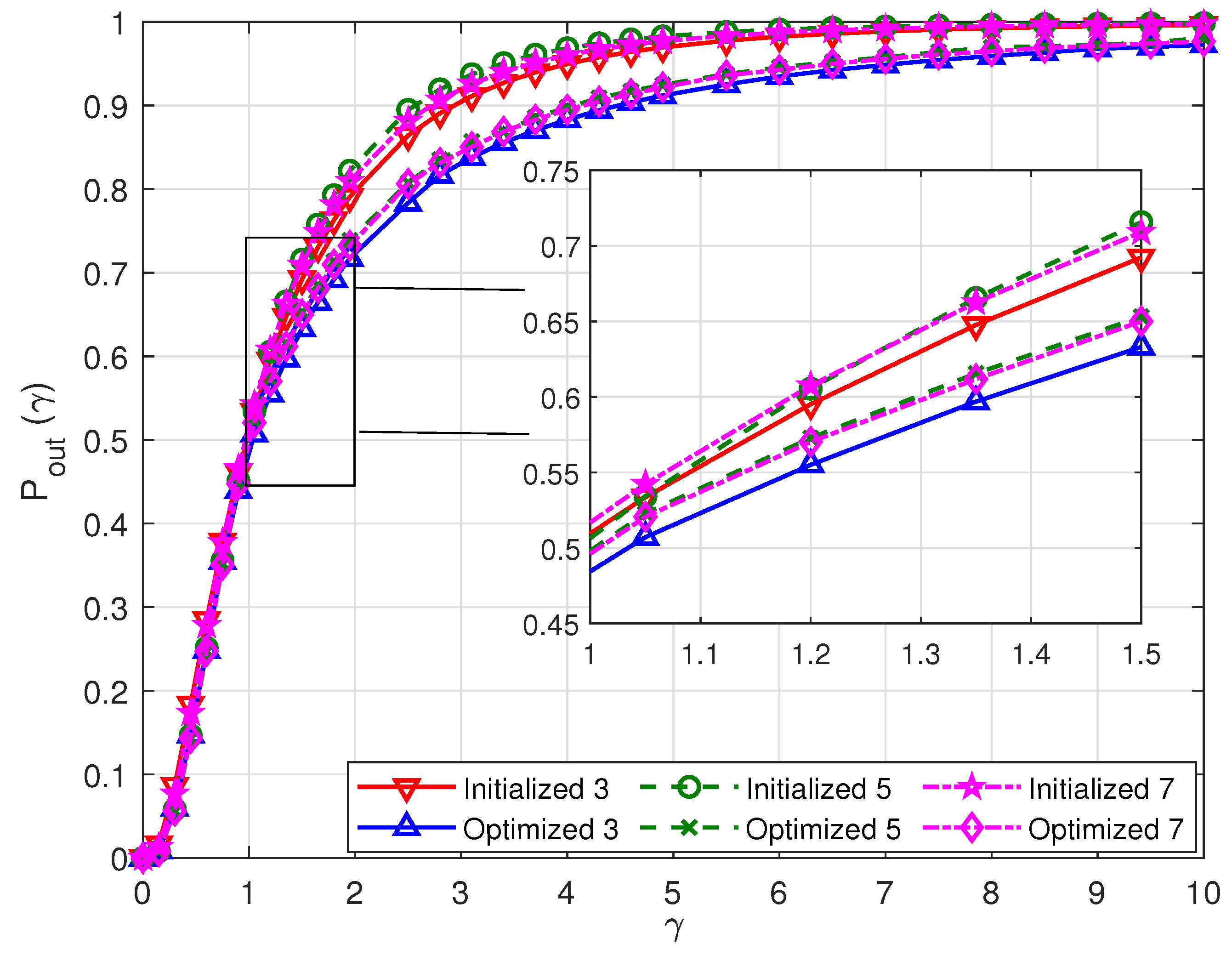Statistical Beamforming for Multi-Set Space–Time Shift-Keying-Based Full-Duplex Millimeter Wave Communications
Abstract
1. Introduction
2. Literature Review
2.1. Shortcomings in the Existing Works
2.2. Our Contributions and Paper Organization
- With the aid of the IQF representation, we express the Signal-to-Interference Ratio (SINR) of the users’ signal at the BS of the MS-STSK-based FD mmWave communication system as the ratio of IQFs.
- We derive the outage probability expression for individual users in the MS-STSK-based FD mmWave communication system by utilizing the characterization of IQF ratio with the aid of conditional probability evaluation.
- We formulate a constrained optimization problem to design both transmit and receive beamforming weights in the MS-STSK-based FD mmWave communication system by minimizing the scalarized sum outage probability of the system while constraining the beamformer weights power to unity.
- We created two techniques to address the proposed constrained optimization problem: the first utilizes the SQP-based heuristic optimization technique and the second employs an iterative procedure of jointly designing the transmit and the receive beamforming algorithm with the aid of the PE and the G-RQ optimization techniques.
3. System Model
4. Outage Probability Analysis
5. Design of Optimum Beamformer Weights
5.1. Heuristic Approach for Joint Optimization of Precoder and Beamformer
5.2. Closed Form Iterative Solution
5.2.1. Transmit Beamforming using Principle Eigenvector Method
5.2.2. Receive Beamforming Using G-RQ Method
| Algorithm 1 Pseudo-code for the ISM algorithm. |
| Require: Set the precision level () and criteria for the algorithm’s termination.
Require: Set the time index . Compute transmit beamfomer weights using (26) to obtain . Repeat the above step for all users, that is, evaluate . Compute the receive beamformer weights using (30) to obtain . Compute the objective function, i.e, using (28). . Evaluate using (28) if then update beamforming weights. else Termination condition = true. end if |
6. Simulation Results
7. Conclusions
Author Contributions
Funding
Data Availability Statement
Conflicts of Interest
References
- Alsabah, M.; Naser, M.A.; Mahmmod, B.M.; Abdulhussain, S.H.; Eissa, M.R.; Al-Baidhani, A.; Noordin, N.K.; Sait, S.M.; Al-Utaibi, K.A.; Hashim, F. 6g wireless communications networks: A comprehensive survey. IEEE Access 2021, 9, 148191–148243. [Google Scholar] [CrossRef]
- Hemadeh, I.; Satyanarayana, K.; El-Hajjar, M.; Hanzo, L. Millimeter-wave communications: Physical channel models, design considerations, antenna constructions and link-budget. IEEE Commun. Surv. Tutor. 2018, 20, 870–913. [Google Scholar]
- MacCartney, G.R.; Samimi, M.K.; Rappaport, T.S. Exploiting directionality for millimeter-wave wireless system improvement. In Proceedings of the 2015 IEEE International Conference on Communications (ICC), London, UK, 8–12 June 2015; pp. 2416–2422. [Google Scholar]
- Satyanarayana, K.; El-Hajjar, M.; Kuo, P.H.; Mourad, A.; Hanzo, L. Dual-function hybrid beamforming and transmit diversity aided millimeter wave architecture. IEEE Trans. Veh. Technol. 2018, 67, 2798–2803. [Google Scholar] [CrossRef]
- Hanzo, L.; El-Hajjar, M.; Alamri, O. Near-capacity wireless transceivers and cooperative communications in the mimo era: Evolution of standards, waveform design, and future perspectives. Proc. IEEE 2011, 99, 1343–1385. [Google Scholar] [CrossRef][Green Version]
- Ishikawa, N.; Sugiura, S.; Hanzo, L. 50 years of permutation, spatial and index modulation: From classic rf to visible light communications and data storage. IEEE Commun. Surv. Tutor. 2018, 20, 1905–1938. [Google Scholar] [CrossRef]
- Mao, T.; Wang, Q.; Wang, Z.; Chen, S. Novel index modulation techniques: A survey. IEEE Commun. Surv. Tutor. 2019, 21, 315–348. [Google Scholar] [CrossRef]
- Sugiura, S.; Chen, S.; Hanzo, L. Space-time shift keying: A unified mimo architecture. In Proceedings of the Globecom, Miami, FL, USA, 6–10 December 2010; pp. 1–5. [Google Scholar]
- Sugiura, S.; Chen, S.; Hanzo, L. Generalized space-time shift keying designed for flexible diversity-, multiplexing- and complexity-tradeoffs. IEEE Trans. Wirel. Commun. 2011, 10, 1144–1153. [Google Scholar] [CrossRef]
- Hemadeh, I.A.; El-Hajjar, M.; Won, S.; Hanzo, L. Layered multi-group steered space-time shift-keying for millimeter-wave communications. IEEE Access 2016, 4, 3708–3718. [Google Scholar] [CrossRef]
- Bharadia, D.; McMilin, E.; Katti, S. Full duplex radios. ACM SIGCOMM 2013, 43, 375–386. [Google Scholar] [CrossRef]
- Everett, E.; Duarte, M.; Dick, C.; Sabharwal, A. Empowering full-duplex wireless communication by exploiting directional diversity. In Proceedings of the 2011 Conference Record of the Forty Fifth Asilomar Conference on Signals, Systems and Computers (ASILOMAR), Pacific Grove, CA, USA, 6–9 November 2011; pp. 2002–2006. [Google Scholar]
- Duarte, M.; Sabharwal, A. Full-duplex wireless communications using off-the-shelf radios: Feasibility and first results. In Proceedings of the Asilomar Conference on Signals, Systems and Computers (ASILOMAR), Pacific Grove, CA, USA, 7–10 November 2010; pp. 1558–1562. [Google Scholar]
- Sabharwal, A.; Schniter, P.; Guo, D.; Bliss, D.W.; Rangarajan, S.; Wichman, R. In-band full-duplex wireless: Challenges and opportunities. IEEE JSAC 2014, 32, 1637–1652. [Google Scholar] [CrossRef]
- Zhang, Z.; Long, K.; Vasilakos, A.V.; Hanzo, L. Full-duplex wireless communications: Challenges, solutions, and future research directions. Proc. IEEE 2016, 104, 1369–1409. [Google Scholar] [CrossRef]
- Satyanarayana, K.; El-Hajjar, M.; Kuo, P.; Mourad, A.; Hanzo, L. Hybrid beamforming design for full-duplex millimeter wave communication. IEEE Veh. Trans. Technol. 2019, 68, 1394–1404. [Google Scholar] [CrossRef]
- Alkhateeb, A.; Heath, R.W. Frequency selective hybrid precoding for limited feedback millimeter wave systems. IEEE Trans. Commun. 2016, 64, 1801–1818. [Google Scholar] [CrossRef]
- Lin, C.T.; Tseng, F.S.; Wu, W.R. MMSE transceiver design for full-duplex MIMO relay systems. IEEE Veh. Trans. Technol. 2017, 66, 6849–6861. [Google Scholar] [CrossRef]
- Sohrabi, F.; Yu, W. Hybrid analog and digital beamforming for mmwave OFDM large-scale antenna arrays. IEEE J. Sel. Areas Commun. 2017, 35, 1432–1443. [Google Scholar] [CrossRef]
- Liu, X.; Xiao, Z.; Bai, L.; Choi, J.; Xia, P.; Xia, X. Beamforming based full-duplex for millimeter-wave communication. Sensors 2016, 16, 1130. [Google Scholar] [CrossRef] [PubMed]
- Roberts, I.P.; Andrews, J.G.; Vishwanath, S. Hybrid Beamforming for Millimeter Wave Full-Duplex Under Limited Receive Dynamic Range. IEEE Trans. Wirel. Commun. 2021, 20, 7758–7772. [Google Scholar] [CrossRef]
- Luo, Z.; Zhang, X.; Gou, L.; Liu, H. Full-Duplex mmWave Communications With Robust Hybrid Beamforming. In Proceedings of the 2021 IEEE Global Communications Conference (GLOBECOM), Madrid, Spain, 7–11 December 2021. [Google Scholar]
- Roberts, I.P.; Chopra, A.; Novlan, T.; Vishwanath, S.; Andrews, J.G. Steer: Beam Selection for Full-Duplex Millimeter Wave Communication Systems. IEEE Trans. Commun. 2022, 70, 6902–6917. [Google Scholar] [CrossRef]
- Nasir, A.A.; Tuan, H.D.; Dutkiewicz, E.; Hanzo, L. Finite-Resolution Digital Beamforming for Multi-User Millimeter-Wave Networks. IEEE Trans. Veh. Technol. 2022, 71, 9647–9662. [Google Scholar] [CrossRef]
- Eltayeb, M.E.; Alkhateeb, A.; Heath, R.W.; Al-Naffouri, T.Y. Opportunistic beam training with analog/digital codebooks for mmwave systems. In Proceedings of the GlobalSIP, Orlando, FL, USA, 14–16 December 2015. [Google Scholar]
- Han, S.; Xu, C.-l.I.Z.; Rowell, C. Large-scale antenna systems with hybrid analog and digital beamformingfor millimeter wave 5G. IEEE Commun. Mag. 2015, 53, 186–194. [Google Scholar] [CrossRef]
- Dutta, S.; Barati, C.N.; Ramirez, D.; Dhananjay, A.; Buckwalter, J.F.; Rangan, S. A Case for Digital Beamforming at mmWave. Trans. Wirel. Commun. 2020, 19, 756–770. [Google Scholar] [CrossRef]
- Zhao, L.; Li, M.; Liu, C.; Hanly, S.V.; Collings, I.B.; Whiting, P.A. Energy Efficient Hybrid Beamforming for Multi-User Millimeter Wave Communication With Low-Resolution A/D at Transceivers. IEEE J. Sel. Areas Commun. 2020, 38, 2142–2155. [Google Scholar] [CrossRef]
- Kaushik, A.; Vlachos, E.; Tsinos, C.; Thompson, J.; Chatzinotas, S. Joint Bit Allocation and Hybrid Beamforming Optimization for Energy Efficient Millimeter Wave MIMO Systems. IEEE Trans. Green Commun. Netw. 2021, 5, 119–132. [Google Scholar] [CrossRef]
- Feng, C.; Shen, W.; Gao, X.; An, J.; Hanzo, L. Dynamic Hybrid Precoding Relying on Twin- Resolution Phase Shifters in Millimeter-Wave Communication Systems. IEEE Trans. Wirel. Commun. 2021, 20, 812–826. [Google Scholar] [CrossRef]
- Qi, C.; Ci, W.; Zhang, J.; You, X. Hybrid Beamforming for Millimeter Wave MIMO Integrated Sensing and Communications. IEEE Commun. Lett. 2022, 26, 1136–1140. [Google Scholar] [CrossRef]
- Borse, I.; Patil, H.D. A Novel Adaptive Beamforming Model for 5G Millimeter Wave Uplink Communication System. In Proceedings of the 2022 2nd International Conference on Artificial Intelligence and Smart Energy (ICAIS), Qinghai, China, 22–26 July 2022. [Google Scholar]
- Bogale, T.E.; Wang, X.; Le, L.B. Chapter 9-mmWave Communication Enabling Techniques for 5G Wireless Systems: A Link Level Perspective, mmWave Massive MIMO; Academic Press: London, UK, 2017; pp. 195–225. [Google Scholar]
- Ji, W.; Zhang, F.; Qiu, L. Multipath Extraction Based UL/DL Channel Estimation for FDD Massive MIMO-OFDM Systems. IEEE Access 2021, 9, 75349–75361. [Google Scholar] [CrossRef]
- Liu, H.; Lu, S.; El-Hajjar, M.; Yang, L. Machine learning assisted adaptive index modulation for mmwave communications. IEEE Open J. Commun. Soc. 2020, 1, 1425–1441. [Google Scholar] [CrossRef]
- Jiang, J.S.; Ingram, M.A. Spherical-wave model for short-range MIMO. IEEE Trans. Commun. 2005, 53, 1534–1541. [Google Scholar] [CrossRef]
- Al-Naffouri, T.Y.; Moinuddin, M.; Ajeeb, N.; Hassibi, B.; Moustakas, A.L. On the distribution of indefinite quadratic forms in gaussian random variables. IEEE Trans. Commun. 2016, 64, 153–165. [Google Scholar] [CrossRef]
- Hassan, A.K.; Moinuddin, M.; Al-Saggaf, U.M.; Al-Naffouri, T.Y. Performance analysis of beamforming in mu-mimo systems for rayleigh fading channels. IEEE Access 2017, 5, 3709–3720. [Google Scholar] [CrossRef]
- Ahmed, R.; Al-Saggaf, U.; Moinuddin, M.; Hassan, A.K. Mitigation of self-interference and multi-user interference in downlink multi-user MIMO system. IET Commun. 2017, 11, 2605–2612. [Google Scholar] [CrossRef]
- Hassan, A.K.; Moinuddin, M.; Al-Saggaf, U.M.; Aldayel, O.; Davidson, T.N.; Al-Naffouri, T.Y. Performance Analysis and Joint Statistical Beamformer Design for Multi-User MIMO Systems. IEEE Commun. Lett. 2020, 24, 2152–2156. [Google Scholar] [CrossRef]
- Lucidi, S. Recursive quadratic programming algorithm that uses an exact augmented lagrangian function. J. Optim. Theory Appl. 1990, 67, 227–245. [Google Scholar] [CrossRef]
- Goldsmith, A.; Jafar, S.A.; Jindal, N.; Vishwanath, S. Capacity limits of MIMO channels. IEEE J. Sel. Areas Commun. 2003, 21, 684–702. [Google Scholar] [CrossRef]





| Task or Challenge | Approach and Assumptions | Shortcomings | Reference |
|---|---|---|---|
| Hybrid beamforming design for full-duplex mmWave communications | Constrained optimization approach using CSI |
| [16] |
| Frequency selective hybrid precoding in mmWave communications | Constrained optimization approach using CSI |
| [17] |
| Transceiver design for full-duplex MIMO relay systems | Minimum Mean Square Error (MMSE) minimization using CSI |
| [18] |
| Hybrid beamforming for mmWave OFDM systems | Constrained optimization using CSI |
| [19] |
| Beamforming for full duplex mmWave communications | Throughput maximization with constrained optimization using CSI |
| [20,21,22,23] |
| Finite-Resolution Digital Beamforming for mmWave communications | Sum rate maximization with sum power constraints using CSI |
| [24] |
| Digital beamforming for mmWave communications |
|
| [25,26,27,28,29,30,31,32] |
Disclaimer/Publisher’s Note: The statements, opinions and data contained in all publications are solely those of the individual author(s) and contributor(s) and not of MDPI and/or the editor(s). MDPI and/or the editor(s) disclaim responsibility for any injury to people or property resulting from any ideas, methods, instructions or products referred to in the content. |
© 2023 by the authors. Licensee MDPI, Basel, Switzerland. This article is an open access article distributed under the terms and conditions of the Creative Commons Attribution (CC BY) license (https://creativecommons.org/licenses/by/4.0/).
Share and Cite
Aljohani, A.J.; Moinuddin, M.; Al-Saggaf, U.M.; El-Hajjar, M.; Ng, S.X. Statistical Beamforming for Multi-Set Space–Time Shift-Keying-Based Full-Duplex Millimeter Wave Communications. Mathematics 2023, 11, 433. https://doi.org/10.3390/math11020433
Aljohani AJ, Moinuddin M, Al-Saggaf UM, El-Hajjar M, Ng SX. Statistical Beamforming for Multi-Set Space–Time Shift-Keying-Based Full-Duplex Millimeter Wave Communications. Mathematics. 2023; 11(2):433. https://doi.org/10.3390/math11020433
Chicago/Turabian StyleAljohani, Abdulah Jeza, Muhammad Moinuddin, Ubaid M. Al-Saggaf, Mohammed El-Hajjar, and Soon Xin Ng. 2023. "Statistical Beamforming for Multi-Set Space–Time Shift-Keying-Based Full-Duplex Millimeter Wave Communications" Mathematics 11, no. 2: 433. https://doi.org/10.3390/math11020433
APA StyleAljohani, A. J., Moinuddin, M., Al-Saggaf, U. M., El-Hajjar, M., & Ng, S. X. (2023). Statistical Beamforming for Multi-Set Space–Time Shift-Keying-Based Full-Duplex Millimeter Wave Communications. Mathematics, 11(2), 433. https://doi.org/10.3390/math11020433






